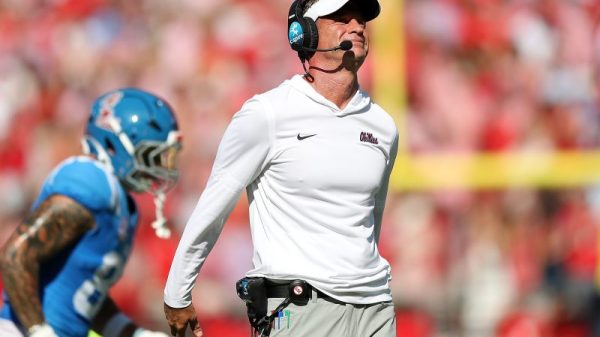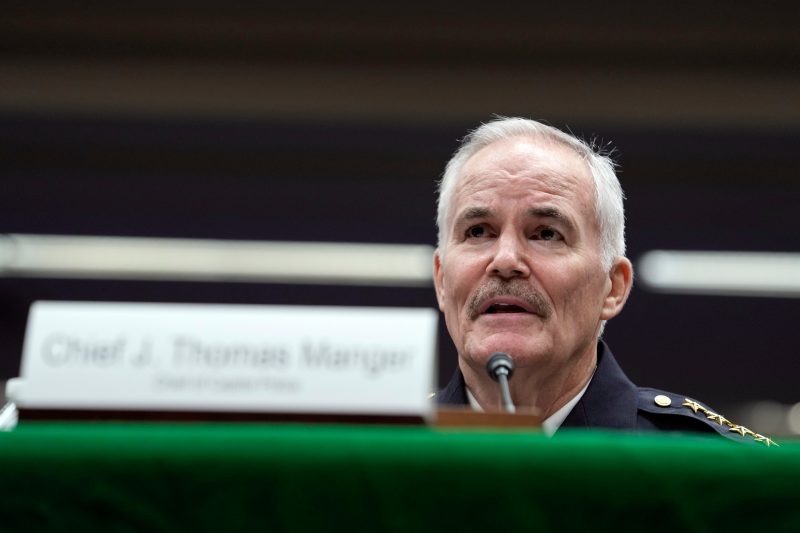The U.S. Capitol Police want to increase the number of field offices they have around the country to investigate threats to members of Congress, and they also want more funding to beef up cooperation with local police departments, the agency’s chief said Tuesday, a day after a man with a baseball bat attacked staff members of Rep. Gerald E. Connolly in the Democrat’s Fairfax City, Va., district office.
Capitol Police Chief J. Thomas Manger also said his department needed to add more officers to its dignitary protection division, which he said is currently 30 percent short of full staffing. The Capitol Police received greatly increased funding after the Jan. 6, 2021, attack on the Capitol, but most of that has been spent on hiring officers and buying equipment for protection of the main Capitol campus, not for members’ security away from Washington, Manger said.
Citing not only the attack on Connolly’s office but also the recent hammer attack on the husband of Rep. Nancy Pelosi (D-Calif.) in their San Francisco home and the 2017 shooting of Rep. Steve Scalise (R-La.) at an Alexandria, Va., baseball field, Manger said: “These events demonstrate how the Capitol Police need to transform into a more protective agency. One that concentrates on protecting members and their families throughout the country, not merely in Washington D.C. … The old approach of member protection has been replaced by the need to protect the members’ environment as well as the members’ family. Keeping you and your families safe must be a top priority.”
Manger said after the hearing that he hoped to set up five or six Capitol Police field offices around the country, adding offices in the Northeast, Midwest and Southwest to existing offices in Florida and California, all located in cities near where many threats originate.
Lawmakers on both sides of the aisle said the attack on Connolly’s staffers brought home the stark dangers they can face, and they supported increased security for the offices in their home districts.
“This shows that people have to think about security in their own offices,” Rep. Jerrold Nadler (D-N.Y.) said. He said Democratic Whip Katherine M. Clark of Massachusetts told party lawmakers earlier Tuesday that the sergeant-at-arms was preparing to talk with lawmakers about security in their home district offices, though he added that his district office is in a federal building with ample security.
Rep. Jim McGovern (D-Mass.) told The Post that lawmakers need to be vigilant — and not just for their own safety.
“I’m not fearful to go back to my district office, but I do worry about the safety of my staff,” he said. McGovern said that in his home district office, members of the public must be buzzed in, a security measure that he said was implemented after the Jan. 6 attack.
The number of possible threats on members of Congress examined by the Capitol Police threat assessment section rose from about 4,000 in 2017 to more than 9,600 in 2021, then declined last year to 7,501. They include phone calls, letters and emails, voice-mail messages and online postings referred to authorities. Capitol Police said many of these instances are “concerning” and are tracked, but do not meet the legal definition of threats. The number of threats that have been prosecuted in recent years has steadily decreased, with federal prosecutors declining charges in 93 percent of cases presented by the police last year, according to Capitol Police statistics.
On Monday, police said a man with a metal baseball bat entered Connolly’s district office on Main Street in Fairfax City, asked for the congressman — who wasn’t there — and then began swinging the bat, hitting two staff members. Both were hospitalized for their injuries and released. The man also smashed computers and fixtures in the office while staffers huddled in a locked room, before Fairfax City police arrived and found him in the lobby, authorities have said.
Xuan Kha Tran Pham, 49, was charged with malicious wounding and aggravated malicious wounding and held in the Fairfax County jail Tuesday. His family said he had a history of mental illness. Fairfax County police said he chased a woman with a bat in a residential neighborhood minutes before he turned up at Connolly’s office; he was gone from that area by the time police arrived.
Manger had already been scheduled to testify Tuesday before the Committee on House Administration, for a hearing titled “Looking Ahead Series: Oversight of the United States Capitol Police.” But most of the questions for Manger were about the Capitol Police response to the insurrection on Jan. 6, before Manger took over.
Shortly before Manger assumed the chief’s job, the Capitol Police opened field offices in San Francisco and Tampa to address the rising number of threats. Republican officials in Tampa earlier this month called on Florida Gov. Ron DeSantis (R) to remove the Capitol Police from the entire state, writing, “The existence of the Capitol Police and the FBI in our state is a global statement that Florida Sheriffs and Peace Officers are incompetent and incapable of doing their jobs.”
Responding to a question from Rep. Laurel M. Lee (R-Fla.) about the Capitol Police presence in her Tampa-area district, Manger said, “There are two, two Capitol police officers and there’s one attorney at that field office. And it helps us in terms of prosecuting criminal cases, because they investigate criminal cases, the threats against Congress. And so it’s much more efficient to have folks posted around the country because our responsibilities are nationwide in terms of those investigative responsibilities.” The Capitol Police are not investigating other crimes, including the Jan. 6 riot, in Tampa, Manger reassured Lee.
For most threat investigations in states around the country, agents travel from D.C. Manger said having field offices was fruitful, “and I think it will be even more fruitful when we can look at places like Chicago, or some place in the Northeast. Because when we look at where these complaints originate, there are more in certain parts of the country.”
In explaining where the additional funding allocated by Congress to the Capitol Police after Jan. 6 has gone, Manger noted that the department had received money “to ask for help and to pay for help from state and local agencies, and that has been a great resource to have, and we’ve got a lot of cooperation, but that needs to continue and it actually needs to increase.”
The agency has credited the San Francisco police in the Pelosi case and the Fairfax City police in the Connolly case for their quick responses. But those were reactions to violent incidents, not the proactivity that Manger told the committee he wants to see in protecting members.
Capitol Police have said previously that with 535 House and Senate members, and each member having at least one office in their district or state, the D.C.-based police can’t cover them all.
“Our agents and investigators are working around-the-clock to carry out our critical mission on Capitol Hill and across the country,” said Tim Barber, the Capitol Police spokesman. “But on top of that, the strong partnerships we have with local law enforcement agencies are extremely important.”
Manger said that his department is able to reimburse local police departments for overtime or other costs incurred when helping protect members.
“With all of the events that members do in their home districts,” Manger told the committee, “we can no longer just say, ‘Boy I hope that goes okay.’ We’ve got to make sure we’re doing everything we can to ensure the safety and security of members while they’re not just here in D.C., but when they’re at home. And this is where the transition to this being a more protective agency really becomes more meaningful.”
After the shooting of then-Rep. Gabrielle Giffords (D-Ariz.) in 2011, the Capitol Police launched a program to add security infrastructure to members’ offices, run through the sergeants-at-arms of the House and Senate. The program provides for alarms, locks and cameras, but not for in-person security.
Connolly said: “There’s a real challenge in making sure we beef up security in district offices to protect our staff and protect our public that comes in to be served. That’s going to be a tall order because we’re talking about hundreds of offices.”
Republican lawmakers weighed in on the issue too. “It’s terrible. We’re praying for Gerry’s staff,” Rep. Chip Roy (R-Tex.) said.
Scalise said he would support any efforts that Connolly proposes to enhance security at his home district office. “Gerry is a great friend and he’s looking into stronger protection for his district office, which every member should do, and it’s a shame that we’re living in times where this is a problem, but we are, so you’ve got to take all the precautions necessary,” Scalise said.



























